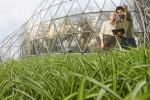The world is entering an era where the support for globalisation, trade liberalisation and the benefits they bring is under threat.
These forces that drove economic growth in the past 40 plus years are giving way to a trend towards nationalism and isolationism across much of the world.
US supremacy in the Pacific is under challenge, and the world is dealing with the rise of authoritarian regimes and social instability.
Free trade and the easy growth that it brought is under threat just as the world requires a radical energy transition towards net zero.
Supply chains have been disrupted by global dislocations, which has produced cost inflation, and resultant interest rate increases that are putting pressure on household budgets.
While Australia has historically benefited from the tailwinds of globalisation, the new era threatens to expose vulnerabilities in the nation’s economic model.
Australia’s economy remains precariously reliant on the dig-and-ship model of resources exploitation with our rating on the economic complexity scale – a proxy for economic potential and resilience – sitting at 93rd in the world Australia alongside Namibia (92) and Kenya (90) in the Harvard Atlas of Economic Complexity.
Reform and productivity growth have stalled throughout what federal Treasurer Jim Chalmers has termed a “a lacklustre decade of wasted opportunities which delivered weak investment, flatlining productivity, stagnant wages, and anaemic growth.”1
During that time we’ve also seen the erosion of Australia’s industrial base with manufacturing and other higher value industries increasingly sent offshore.
The result has been a less resilient economy - one that faces challenges adapting to geopolitical tensions, supply chain disruptions and the energy transition.
Australia’s renewable energy advantages and reserves of critical minerals have the capacity to play a role in putting the nation on a firmer economic footing, deepening our trade relationships and creating sustainable growth.
In this report we explain how unlocking “green” growth – in industries such as hydrogen and critical minerals - will require partnership with our leading trading partners, most specifically Japan.
This partnership could be as significant as previous trade and investment collaborations between our nations that have significantly contributed to GDP growth (in agriculture, LNG and iron ore).
But the old playbook – pairing Japanese capital and Australian raw materials – will need to be rewritten to ensure Australia moves up the export value chain to enhance its economic resilience and generate the kind of jobs the Treasurer spoke about in his model of “values-based capitalism”.
The Challenge
In this less secure world, Australia has looked to progress bilateral and multilateral security partnerships with our ally, the US, and other regional security partners.
The formation of AUKUS (and the deal for Australia to secure US nuclear submarines and produce missiles for US military use) and the Quad (Australia, Japan, India and the US) are examples of this.
But the cancellation of the Quad meeting in Sydney in May 2023, after US President Joe Biden opted to stay home to deal with domestic issues, highlights the risk in relying on these arrangements alone.
The US is also charting its own course on carbon abatement and inflation management through the US$520b Inflation Reduction Act providing funding for renewable energy investment and critical mineral supply on its road to net zero.
The Australian Government is under pressure to scale up its investment in, and support of, clean energy.
The CEO of large ASX-listed lithium and iron ore producer Mineral Resources, Chris Ellison, said recently that “every government around the world is urgently competing for the same investment”
“They’re throwing cash and tax incentives on the table and making it cheaper and faster to get projects done,” he said. “It’s a global sprint for capital, and Australia will need serious and targeted government support to even be in the race.”2
While the $2b Hydrogen Headstart program is a good first step, both industry and Government recognise more needs to be done.
So why is Japan our potential saviour here? There are the obvious answers - it is a long-term partner, a leading source of FDI and vital to our previous successes in developing our capital-intensive resource industries. Japan shares our democratic values and is becoming a vital defence partner.
And it is deeply invested in the transition and keen to partner with Australia. The 2023 Decarbonising Australia Business Summit in Sydney featured all the major players in the space from Japan. Japan’s Consul-General Shuichi Tokuda told attendees Australia was “a key partner for Japan in the journey of decarbonisation” noting the country’s role as a stable supplier of conventional energy and the extent of Japanese involvement in decarbonisation projects in Australia. Assistant Minister for Trade Tim Ayres told the summit that all Australian governments saw “Japan as a vital partner in our shared net-zero future”.
Japan won’t be the only Asian partner we have on the energy transition – South Korea and India have established critical minerals partnerships with Australia and there is already an example of Australian-Korean co-investments in developing a critical minerals supply chain.
Resources minister Madeleine King has already said foreign investment in Australian critical minerals will only be available to “like-minded” investors. That’s code for nations that observe the “rules-based global order”.
The other way to look at the potential for collaboration is that Japan (and South Korea) and Australia sit at opposite ends of the economic complexity scale on the Harvard Atlas of Economic Complexity.3
Japan has long had the most complex economy in the world and that has been a proxy for economic resilience and growth. South Korea is not far behind at #3 in the world.
Australia, on the other hand, sits at 93rd in the world between Uganda (92) and Pakistan (94).
Australia needs to become a more complex economy, with a diversified industrial base including vibrant new industries, and reduce its reliance on the “dig-and-ship” model of resource export.
The benefits of this shift are obvious. From 1995 to 2017, Singapore (a nation with no natural resources) expanded its economy by creating sophisticated products and industries that generated US$2560 value per Singaporean. In the same period, Australia broke into seven new products (metal ores; ammonia, rare earths, activated carbon, hydrochloric acid, scrap rubber and wax residues) and the economic value they generated was US$33 per Australian.4
To remain at number one, Japan needs to make its economic activity less carbon intensive – not so easy for an energy importer with limited potential for renewable energy generation.
There’s an opportunity here for the two nations to collaborate effectively to create opportunity and develop supply chains based on comparative advantage and geographical efficiency.
Australia has the chance to leverage Japan’s technology, investment and knowledge to create a more diversified and resilient economy by “on-shoring” the processing of critical minerals and production of hydrogen for offshore transportation and downstream beneficiation (through the production of fertilisers, sustainable fuels).
And Australia can help Japan’s transition to a zero carbon through a green energy export industry centred on using Australia’s natural resources in a way that facilitates sustainable growth in both economies.
Establishing a seaborne green energy trade centred on hydrogen vectors may prove to be just as pivotal in the Australia Japan story as post war agricultural trade, and the development of the iron ore and LNG industries.
It’s a trade that’s dependent on abundant renewable energy, space for carbon capture and storage and critical minerals for the building blocks of a net zero world - batteries, EVs (expected to account for 60% of vehicle sales by 2030), solar panels and wind turbines.5
While this has the potential to be another complimentary collaboration, there will need to be trade-offs on both sides.
Japan will have to accept that more of the processing of raw materials, whether that’s green hydrogen or critical minerals such as rare earth metals and lithium, will need to be done in Australia to satisfy the need to expand the complexity and resilience of the Australian economy.
Australia will have to commit to fostering these industries in a more meaningful way to ensure they have the conditions to scale production. And it will have to think more creatively about moving up the value chain by using green hydrogen to power the production of value-added products such as steel or aluminium. If Australia wrestles with social license challenges resulting from the use of land at scale to produce green energy, perhaps it can lean on Japan / Asia to continue to drive technological breakthroughs that reduce this land impost.
While Australia’s ESG credentials and regulatory framework enhance its attractiveness as an export partner, the Australian government will also have to persuade a sometimes sceptical public that the path to decarbonisation requires more mining not less. For these industries to develop and deliver the carbon abatement required they will not only need support, but an absence of roadblocks in the form of planning delays, red tape and punitive taxes. Even clean projects such as onshore wind farms are now being opposed by environmental activists despite their potential in reducing carbon emissions and projects enhancing grid connectivity involving above-ground power lines are vehemently opposed by local landowners.
.jpg)
The Path Forward
Australia’s clean energy resources are considerable. It has substantial reserves of the critical minerals that will make or break the clean energy transition through production of electric vehicles, batteries, solar panels and wind turbines.
The value of these reserves of lithium, rare earths and other technology metals is illustrated by the fact that the aggregate value of major ASX-listed critical minerals companies has risen from $8.6b to $86.2b in the past decade.6 The basket of 33 critical mineral stocks on the exchange is now worth more than the so-called gold index comprised of the 25 leading gold producers on the ASX.
The Australian government’s recently released Critical Minerals Strategy 2023-2030 included modelling that found the country could add $71.2b in GDP and 115,000 jobs by 2040 by just keeping pace with export demand for these minerals. Adding downstream refining and processing capability could roughly double these returns, research commissioned by the Department of Industry, Science and Resources found.
Australia has very high potential for solar and wind energy that can be used to power hydrogen production producing a clean fuel that releases water when it combusts.
Along with renewable energy potential, Australia also has options for carbon capture that may also play a role in hydrogen production.
The first tentative steps towards developing a hydrogen industry in Australia have already been taken.
As at March 2023, the CSIRO – Australia’s peak government scientific body - lists 113 hydrogen/ammonia/methanol projects in Australia, of which approximately 50% have Japanese involvement.7
The first shipment of hydrogen produced in Victoria's Latrobe Valley coalfields was shipped to Japan in 2022 as part of the Hydrogen Energy Supply Chain (HESC) project. The hydrogen was produced from brown coal through a gasification process. The Japanese government is supporting this project with JPY220 billion (approximately $2.35 billion) in funding.
HESC involves major Japanese players Japan Suiso Energy and the J-POWER/Sumitomo Corporation Joint Venture.

The project plans to use depleted natural gas wells in Bass Strait to store the carbon dioxide produced in the process to reduce its carbon intensity.
The project’s Japanese backers recently called for clearer backing from the state and federal government after the Albanese government ruled out fossil fuel-based projects from its $2b Hydrogen Headstart funding scheme.8 The proponent warned the project may not go ahead without clearer signs of support amid lukewarm backing from governments for projects that involve carbon capture and storage.9
While these projects are aimed at exporting hydrogen, more value might be unlocked by using hydrogen at source to create higher value or domestically consumed products such as converting green hydrogen to ammonia fertiliser or using it to replace conventional energy sources for energy intensive processes such as steel and aluminium production.
There are many energy-dependent production processes currently done offshore that might be better shifted closer to the source of the green energy that is needed to power them.
Moving this production to Australia would improve the resilience of the Australian economy, albeit at some detriment to Japan. Although with the constraints on space and the availability of workers (amid demographic change), there may be some areas where Japan is content to accept a shift in order to capture the benefit of secure clean energy supply.
The trade-off Australia could make is in guaranteeing supply so that these projects get first call on the finite production of low carbon energy.
Taking this concept even further, there is the potential for the creation of clean energy ecosystems in the future. For example, this kind of venture could see the production of green hydrogen from solar power, the hydrogen can be turned into green steel for shipbuilding and green methanol to power ships to transport excess hydrogen to Japan.

Similar potential exists in defence shipbuilding where green steel could be utilised in vessels produced to safeguard both Japan and Australia’s security.
There isn’t a shortage of local capital to realise these types of initiatives – Australian superannuation funds are constantly seeking investment avenues – what is needed are economic and bankable investment theses. There is likely to be a major role for the Australian and Japanese governments to provide a framework to underpin private sector investment and create benefits in terms of jobs and GDP growth, as well as creating another viable asset class for these large Australian institutional investors.
Australia’s reserves of critical minerals also offer benefits in terms of defence collaboration with rare earth metals used extensively in defence applications. Japan, the US and European nations are heavily invested in securing a non-China supply to break that country’s stranglehold on the market in these commodities.
There has been progress in critical mineral supply with it being on the agenda of AUKUS and Quad meetings and also featuring in recent bilateral clean energy pacts between Australia and the US (the Australia-United States Climate, Critical Minerals and Clean Energy Transformation Compact 2023) and Australia and Japan (Critical Minerals Partnership 2022).
Companies such as Lynas Rare Earths are already supplying Japanese buyers with rare earth elements, but there is the opportunity to do more.
Supply of Heavy Rare Earths (HRE) to Japan by Lynas Rare Earths
In March 2023, Lynas Rare Earths secured $200m in investment from Japan Australia Rare Earths, a joint venture between Japan’s state-owned Japan Organization for Metals and Energy Security (JOGMEC) and Sojitz Corporation. The deal provides a stable supply of rare earths to Japan by diversifying the supply sources which are currently concentrated to China.
Rare earths, divided into light and heavy rare earths, are used in various industries including the production of magnets for motors for electric vehicles and wind turbines.

Source: Sojitz Corporation, Japan Organization for Metals and Energy Security
Similarly nuclear energy offers another future opportunity of this nature, albeit one that is fraught with controversy in both countries – Japan through the Fukushima disaster and Australia through its strong anti-nuclear movement. But times change and the rapidity of the decarbonisation challenge have put nuclear back on the agenda. Australian Opposition Leader Peter Dutton has already flagged his willingness for a debate on building modular reactors to supply power in Australia.
Instead of shipping uranium to Japan and other approved nations under the current paradigm, were Australia to establish a civil nuclear energy program, it would allow this energy to be used to create higher value-added products - such as steel or aluminium - that could be used to meet Japan and Australia’s needs. Nuclear energy could also be used to generate zero emissions hydrogen.
Japan is a potential supplier of next-gen nuclear technology with companies such as Hitachi and others focused on small modular nuclear reactors or thorium molten salt technology.
Prime Minister Anthony Albanese has spoken of his desire to develop domestic battery products in Australia to boost manufacturing capability and accelerate the journey to net zero. That attracted some scepticism from experts about Australia’s ability to compete with existing battery making nations, which include Japan, China and Korea, but there was support for moving further up the value chain in turning raw lithium into refined lithium hydroxide (which is being done to a degree) and one step further into cathode active material that can go into a battery.
Andrew Tong, executive manager of cobalt producer Cobalt Blue, said the geopolitical circumstance and Australia’s history of close collaboration with Japan offered an opportunity for us to move further up the value chain. “Our expertise is [in] digging it up and processing it to a certain point in the chain. Can we transition from the raw materials into a manufactured good?”.10
All these ecosystems will depend on close co-operation and the exchange of capital and technology of the kind that Australia and Japan have enjoyed since 1957. At an industry level, the benefits in each case may be more skewed to one country or the other, but if all avenues are pursued the benefits at a portfolio level are likely to be more equally shared.
Conclusion
Collaboration between Australia and Japan on decarbonisation - and by extension hydrogen and critical minerals - has the potential to be transformative for both countries.
It can accelerate Australia’s transition towards being a more sophisticated economy less vulnerable to depending on commodity exports. It can safeguard Japan’s energy future and help the world on the path to net zero.
Drawing on a proud history of economic and diplomatic collaboration, the two countries are uniquely placed to assist each other with access to trust, capital, regulatory stability, technology, raw materials, labour and renewable energy and carbon storage capacity.
But the next iteration of the Japan Australia partnership will be different and require courage, patience and flexibility on both sides from both the private and public sector.
From an Australian perspective it will need the government to embrace long-term thinking that sacrifices immediate gain for long-term economic stability and the creation of new industries.
Getting this right will capture more of the benefits and create a more complex and resilient economy.
In critical minerals it will ensure we capture more of the value and begin to rebuild an industrial base by adding processing to the supply chain.
Clean hydrogen can be a viable export industry through collaboration with Japanese partners. Using that clean hydrogen domestically to generate value-added products – such as ammonia for fertiliser and even “green” steel or aluminium - is a longer-term proposition but it offers greater rewards.
In turn, using these products to move further up the change into defence and shipbuilding or other industries takes this a step further.
From a Japanese perspective, these opportunities offer an opportunity to invest capital in projects that can generate returns and are positively exposed to decarbonisation and can underpin Japan’s energy supply. 11, 12
In our view, the two countries can leverage the maturity of the trade and investment relationship [and our defence pact] to create structures that facilitate a range of investments where the benefits may be skewed to one nation or the other but in aggregate generate meaningful benefits for both countries and for the planet.
References
2 https://www.afr.com/companies/mining/pm-s-battery-dream-admirable-but-unlikely-ceos-20230228-p5co8j
3 https://atlas.cid.harvard.edu/
4 https://www.afr.com/policy/economy/australia-is-rich-dumb-and-getting-dumber-20191007-p52y8i
8 https://arena.gov.au/funding/hydrogen-headstart/
11 Basic Hydrogen Strategy (2023): https://www.meti.go.jp/shingikai/enecho/shoene_shinene/suiso_seisaku/pdf/20230606_5.pdf
12 Overview of the Basic Hydrogen Strategy (2023): https://www.meti.go.jp/shingikai/enecho/shoene_shinene/suiso_seisaku/pdf/20230606_4.pdf
Contact us













